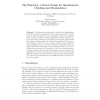ICRA
2008
IEEE
14 years 7 months ago
2008
IEEE
Abstract— Researchers have addressed the localization problem for mobile robots using many different kinds of sensors, including rangefinders, cameras, and odometers. In this pa...
ICRA
2008
IEEE
14 years 7 months ago
2008
IEEE
— We present results of successful telemanipulation of large, heavy objects by a humanoid robot. Using a single joystick the operator controls walking and whole body manipulation...
ICRA
2008
IEEE
14 years 7 months ago
2008
IEEE
— In this work a novel control method is presented for controlling the forward speed and apex height of a special class of running quadruped robot, with a dimensionless inertia o...
ICRA
2008
IEEE
14 years 7 months ago
2008
IEEE
— In this paper a novel multipart control is developed for a trotting quadruped robot. The control is designed to drive the quadruped to a steady-state motion with desired forwar...
ICRA
2008
IEEE
14 years 7 months ago
2008
IEEE
— Facing new tasks, the conventional rigid design of robotic joints has come to its limits. Operating in unknown environments current robots are prone to failure when hitting unf...
HRI
2010
ACM
14 years 7 months ago
2010
ACM
—Managing user expectations of personal robots becomes particularly challenging when the end-user just wants to know what the robot can do, and neither understands nor cares abou...
MICAI
2009
Springer
14 years 7 months ago
2009
Springer
People detection and tracking is a key issue for social robot design and effective human robot interaction. This paper addresses the problem of detecting people with a mobile robo...
ISCIS
2009
Springer
14 years 7 months ago
2009
Springer
—In this paper, we study how a humanoid robot can learn affordance relations in his environment through its own interactions in an unsupervised way. Specifically, we developed a...
ICMI
2009
Springer
14 years 7 months ago
2009
Springer
Social interactions unfold over time, at multiple time scales, and can be observed through multiple sensory modalities. In this paper, we propose a machine learning framework for ...
ICIRA
2009
Springer
14 years 7 months ago
2009
Springer
We present a novel approach to mobile object manipulation for service in indoor environments. Current research in service robotics focus on single robots able to move, manipulate o...


